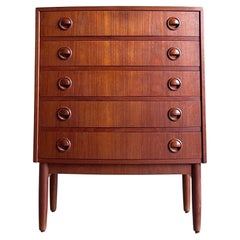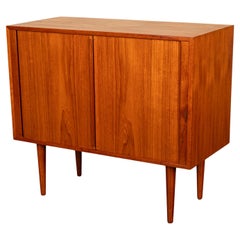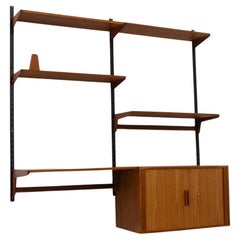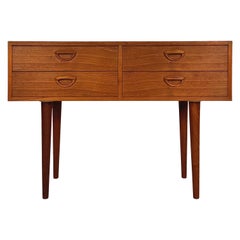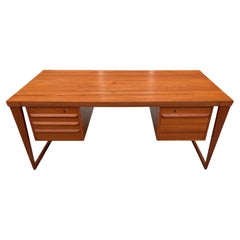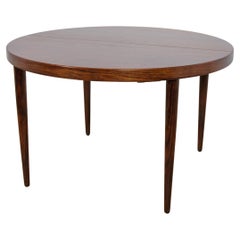Feldballes Møbelfabrik
| Average Sold Price |
| $2,818 |
| Styles |
| Materials |
| Related Creators |
Kai Kristiansen teak chest of drawers by Feldballes Møbelfabrik, Denmark
By Kai Kristiansen, Feldballes Møbelfabrik
Located in Bern, CH
Kai Kristiansen teak chest of drawers. With five drawers. Produced by Feldballes Feldballes Møbelfabrik, Denmark ca. 1960. Lovely detailing to handles.
In beautiful original conditio...
Category
Mid-20th Century Danish Mid-Century Modern Feldballes Møbelfabrik
Materials
Teak
$2,290
H 30.32 in W 23.63 in D 12.6 in
Danish Sideboard 60s Design Kai Kristiansen for Fedeballes Møbelfabrik
By Feldballes Møbelfabrik, Kai Kristiansen
Located in None, IT
Rosewood sideboard, with two front doors and one upper flap door, inside a top and three drawers. Design Kai Kristiansen for Feldballes Møbelfabrik, 1960s.
Condition: In excellent...
Category
1960s Danish Scandinavian Modern Vintage Feldballes Møbelfabrik
Materials
Rosewood
$1,310 Sale Price
44% Off
H 29.93 in W 33.86 in D 18.51 in
Danish MCM Tambor Roll Front Teak Credenza Cabinet Kai Kristiansen Feldballes
By Kai Kristiansen, Feldballes Møbelfabrik
Located in Portland, OR
A good diminuitive tambor roll front Danish Mid Century Modern teak cabinet/credenza, circa 1960, by Kai Kristiansen for Feldballes Møbelfabrik.
The cabinet is of diminuitive form and has twin tambor roll-front doors, enclosing four storage areas, the cabinet is raised on circular tapered legs.
The cabinet is made from figured grain teak and is in excellent condition, this elegant & classic MCM cabinet...
Category
1960s Danish Mid-Century Modern Vintage Feldballes Møbelfabrik
Materials
Teak
$1,795
H 30 in W 34 in D 15.75 in
Vintage Danish Modular Teak Wall Unit by Kai Kristiansen for FM, 1960s.
By Feldballes Møbelfabrik, Kai Kristiansen
Located in Asaa, DK
Vintage Danish modular teak wall unit by Kai Kristiansen for Feldballes Møbelfabrik, Denmark, 1960s
Vintage modular 2 bay shelving system model FM Reolsystem.
This set consist of:
...
Category
1960s Danish Scandinavian Modern Vintage Feldballes Møbelfabrik
Materials
Teak
$2,500
H 69.3 in W 68.9 in D 16.34 in
Kai Kristiansen Chest of Drawers Teak Feldballes Denmark 1960s
By Feldballes Møbelfabrik, Kai Kristiansen
Located in Basel, BS
Kai Kristiansen chest of drawers, model FM 52 for Feldballes Møbelfabrik, made in Denmark in the late 1950s to early 1960s.
Perfect as an entry hall furniture...
Category
1960s Danish Mid-Century Modern Vintage Feldballes Møbelfabrik
Materials
Teak
Kai Kristiansen Executive Teak Desk Model 70
By Kai Kristiansen, Feldballes Møbelfabrik
Located in Philadelphia, PA
Beautiful Kai Kristiansen Teak Desk with drawers and front cabinets! Desk opening is 24.5 wide and 26.5 high. Sled Style Runner Legs. One of Kristiansen's finest and most iconic d...
Category
1950s Danish Scandinavian Modern Vintage Feldballes Møbelfabrik
Materials
Teak
Desk Made In Teak Model 54 By Kai Kristiansen For Feldballes Furniture From 1950
By Feldballes Møbelfabrik, Kai Kristiansen
Located in Lejre, DK
The desk, known as Model 54, is a brilliant example of mid-20th century Danish design. Designed by the renowned furniture designer Kai Kristiansen in 1954 and produced by Feldballes ...
Category
1950s Danish Mid-Century Modern Vintage Feldballes Møbelfabrik
Materials
Teak
$4,734
H 29.53 in W 54.34 in D 27.56 in
Mid-Century Extendable Rosewood Dining Table by Kai Kristiansen for Feldballes
By Feldballes Møbelfabrik, Kai Kristiansen
Located in GNIEZNO, 30
This dining table designed Kai Kristiansen and manufactured by Feldballes Møbelfabrik in Denmark in the 1960s.Beautiful, rich wood grain, high-quality woodwork and a thick top give ...
Category
1960s Danish Mid-Century Modern Vintage Feldballes Møbelfabrik
Materials
Rosewood
$3,394
H 27.96 in W 45.28 in D 45.28 in
Browse all Furniture from Feldballes Møbelfabrik
Shop NowFeldballes Møbelfabrik Sale Prices
This data represents a recent sample of sales made on 1stDibs during the specified years. All sales are anonymized.
| Sold Date | Sold Price | Category | Material | Creation Year | |||||||||||||||||||||||||||||||||||||||||||||||||||||||||||||
|
| $2,818 |
Average sold price of items in the past 12 months |
| $321-$6,750 |
| Sold price range of items in the past 12 months |
Creators Similar to Feldballes Møbelfabrik
Feldballes Møbelfabrik furniture for sale on 1stDibs.
Feldballes Møbelfabrik furniture are available for sale on 1stDibs. These distinctive items are frequently made of wood and are designed with extraordinary care. There are many options to choose from in our collection of Feldballes Møbelfabrik furniture, although brown editions of this piece are particularly popular. Many of the original furniture by Feldballes Møbelfabrik were created in the mid-century modern style in scandinavia during the 20th century. If you’re looking for additional options, many customers also consider furniture by C.M. Madsen, Svend Åge Madsen, and Falster Møbelfabrik. Prices for Feldballes Møbelfabrik furniture can differ depending upon size, time period and other attributes — on 1stDibs, these items begin at $293 and can go as high as $9,345, while a piece like these, on average, fetch $3,618.
